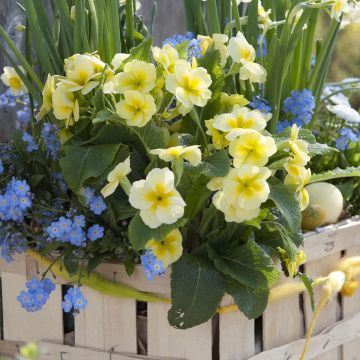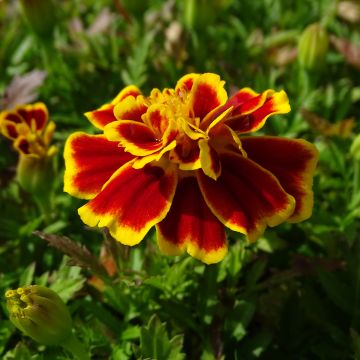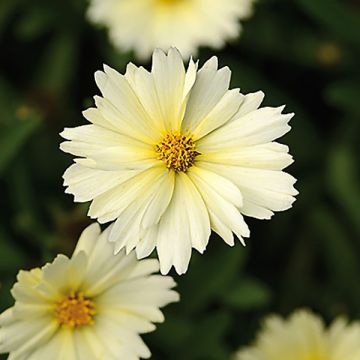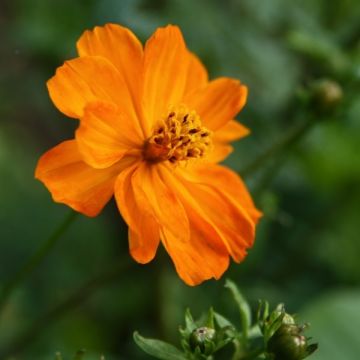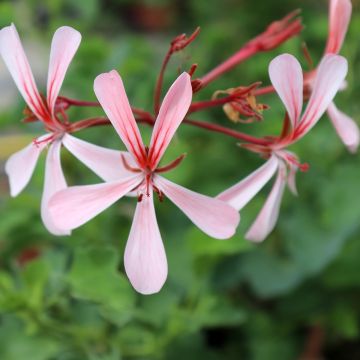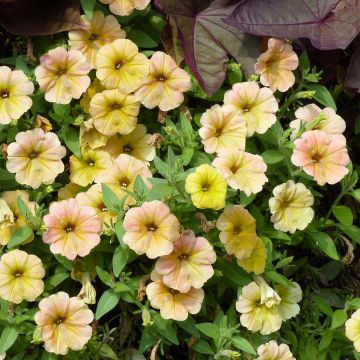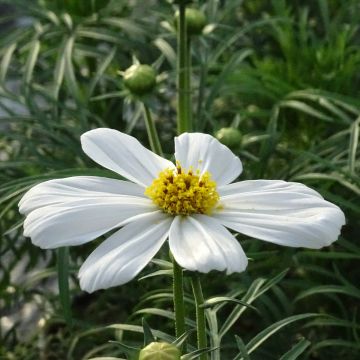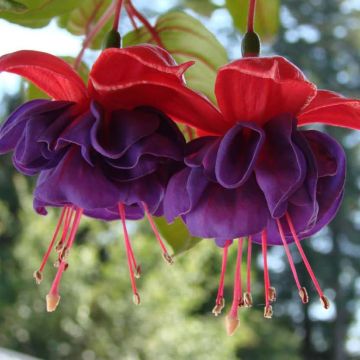

Primevère double Belarina Baltic Blue - Primula vulgaris
Primula vulgaris Belarina Baltic Blue- English Primrose
Primula vulgaris Belarina Baltic Blue
Primrose, English Primrose, Common Primrose
beautiful double flowers, rather violet
Nad06, 22/03/2024
This plant carries a 6 months recovery warranty
More information
We guarantee the quality of our plants for a full growing cycle, and will replace at our expense any plant that fails to recover under normal climatic and planting conditions.
From €5.90 for pickup delivery and €6.90 for home delivery
Express home delivery from €8.90.

Does this plant fit my garden?
Set up your Plantfit profile →
Description
The 'Belarina Baltic Blue' double primrose charms with its two-tone blue flowers, strongly veined with dark blue on a sky blue background. They are very double, discreetly adorned with small golden spots at the throat. They rest in generous clusters on another bouquet composed of wide, wavy green leaves. The pretty double primroses had almost disappeared from catalogs. Thanks to new selections that are more perennial and more floriferous, they are finding their way back into our gardens, window boxes, flower beds, and borders. Offering a multitude of colors and a breath of optimism at the end of winter, they even grow in shade and flower for a long time.
The Primula vulgaris (acaulis) Belarina Baltic Blue is a herbaceous perennial plant of the primrose family, derived from the common primrose commonly found in our meadows and woodlands. It is part of a series of recent developments that are distinguished by the doubling of their corollas, their very vibrant colours, and their extended flowering period. These are floriferous and hardy plants that form lovely clumps of foliage in just a few months, reaching heights of 15 to 20 cm (6 to 8in) and widths of 20 to 30 cm (8 to 12in). They develop rosettes of wavy and veined leaves, which remain evergreen in winter. 'Belarina Baltic Blue' produces 3 to 4 cm (1 to 2in) diameter flowers, which appear for 4 to 5 weeks. They are very double, resembling small roses of an indescribable blue, gathered in perfect clusters. They are beautiful, but also slightly fragrant and carried by short villous peduncles surrounded by luxuriant foliage.
Garden primroses are perennial plants grown as biennials. Perfect in pots, window boxes, flower beds, and borders, and even growing in shade in fertile and moist soil, they deserve a place in every garden and on every balcony. They announce and precede the return of spring along with botanical tulips, pansies and violas, and forget-me-nots. Ideal under the cover of deciduous trees, in rockeries, and short grass meadows, they slip among snowdrops and violets. The leaves and flowers are edible and can be consumed raw or cooked.
Note: Attention, our plug plants are professional products reserved for experienced gardeners: upon receipt, transplant them as soon as possible, in pots, window boxes, or directly in flower beds.
Report an error about the product description
Primula vulgaris Belarina Baltic Blue- English Primrose in pictures
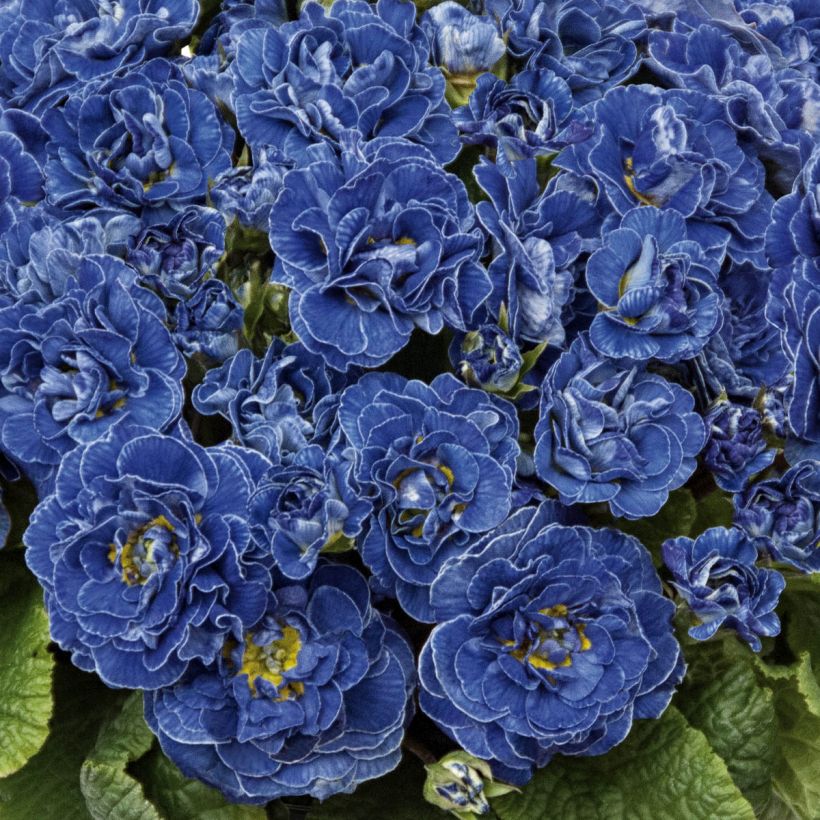

Flowering
Foliage
Plant habit
Botanical data
Primula
vulgaris
Belarina Baltic Blue
Primulaceae
Primrose, English Primrose, Common Primrose
Cultivar or hybrid
Other Garden primroses
Planting and care
The plug plants of double primroses 'Belarina' are planted in pots and containers or directly in the ground in a finely prepared and enriched soil. Plant them as soon as possible, in September-October if possible. If the planned location is not ready yet or if the conditions are unfavorable for planting, you can let them grow in buckets for 4 to 6 weeks.
In pots and containers, use a good potting soil for flowering plants (geranium-type potting soil) enriched with clay and slow-release fertilizer, light and well-draining. The top of the plug should be level with the potting soil. Water generously at planting and during the following weeks, as the plug plants can dry out quickly. However, be careful with excess water! Make sure to use containers with drainage holes and empty the saucer 10 minutes after watering. Remember to water even during winter if it doesn't rain or if the container is placed in a sheltered location. Do not water during freezing periods.
Very floriferous and fast-growing, the perennial primroses 'Belarina' are hungry plants. As soon as growth resumes, in late February or early March, and throughout the flowering period, apply a liquid fertilizer for flowering plants containing iron and trace elements 1 to 2 times a week with the watering water. Remove faded flowers to promote new blooms. Once the flowering is over, plants in pots can be replanted in the garden in partial shade.
Planting period
Intended location
Care
-
, onOrder confirmed
Reply from on Promesse de fleurs
Plug plants - Annuals
Haven't found what you were looking for?
Hardiness is the lowest winter temperature a plant can endure without suffering serious damage or even dying. However, hardiness is affected by location (a sheltered area, such as a patio), protection (winter cover) and soil type (hardiness is improved by well-drained soil).

Photo Sharing Terms & Conditions
In order to encourage gardeners to interact and share their experiences, Promesse de fleurs offers various media enabling content to be uploaded onto its Site - in particular via the ‘Photo sharing’ module.
The User agrees to refrain from:
- Posting any content that is illegal, prejudicial, insulting, racist, inciteful to hatred, revisionist, contrary to public decency, that infringes on privacy or on the privacy rights of third parties, in particular the publicity rights of persons and goods, intellectual property rights, or the right to privacy.
- Submitting content on behalf of a third party;
- Impersonate the identity of a third party and/or publish any personal information about a third party;
In general, the User undertakes to refrain from any unethical behaviour.
All Content (in particular text, comments, files, images, photos, videos, creative works, etc.), which may be subject to property or intellectual property rights, image or other private rights, shall remain the property of the User, subject to the limited rights granted by the terms of the licence granted by Promesse de fleurs as stated below. Users are at liberty to publish or not to publish such Content on the Site, notably via the ‘Photo Sharing’ facility, and accept that this Content shall be made public and freely accessible, notably on the Internet.
Users further acknowledge, undertake to have ,and guarantee that they hold all necessary rights and permissions to publish such material on the Site, in particular with regard to the legislation in force pertaining to any privacy, property, intellectual property, image, or contractual rights, or rights of any other nature. By publishing such Content on the Site, Users acknowledge accepting full liability as publishers of the Content within the meaning of the law, and grant Promesse de fleurs, free of charge, an inclusive, worldwide licence for the said Content for the entire duration of its publication, including all reproduction, representation, up/downloading, displaying, performing, transmission, and storage rights.
Users also grant permission for their name to be linked to the Content and accept that this link may not always be made available.
By engaging in posting material, Users consent to their Content becoming automatically accessible on the Internet, in particular on other sites and/or blogs and/or web pages of the Promesse de fleurs site, including in particular social pages and the Promesse de fleurs catalogue.
Users may secure the removal of entrusted content free of charge by issuing a simple request via our contact form.
The flowering period indicated on our website applies to countries and regions located in USDA zone 8 (France, the United Kingdom, Ireland, the Netherlands, etc.)
It will vary according to where you live:
- In zones 9 to 10 (Italy, Spain, Greece, etc.), flowering will occur about 2 to 4 weeks earlier.
- In zones 6 to 7 (Germany, Poland, Slovenia, and lower mountainous regions), flowering will be delayed by 2 to 3 weeks.
- In zone 5 (Central Europe, Scandinavia), blooming will be delayed by 3 to 5 weeks.
In temperate climates, pruning of spring-flowering shrubs (forsythia, spireas, etc.) should be done just after flowering.
Pruning of summer-flowering shrubs (Indian Lilac, Perovskia, etc.) can be done in winter or spring.
In cold regions as well as with frost-sensitive plants, avoid pruning too early when severe frosts may still occur.
The planting period indicated on our website applies to countries and regions located in USDA zone 8 (France, United Kingdom, Ireland, Netherlands).
It will vary according to where you live:
- In Mediterranean zones (Marseille, Madrid, Milan, etc.), autumn and winter are the best planting periods.
- In continental zones (Strasbourg, Munich, Vienna, etc.), delay planting by 2 to 3 weeks in spring and bring it forward by 2 to 4 weeks in autumn.
- In mountainous regions (the Alps, Pyrenees, Carpathians, etc.), it is best to plant in late spring (May-June) or late summer (August-September).
The harvesting period indicated on our website applies to countries and regions in USDA zone 8 (France, England, Ireland, the Netherlands).
In colder areas (Scandinavia, Poland, Austria...) fruit and vegetable harvests are likely to be delayed by 3-4 weeks.
In warmer areas (Italy, Spain, Greece, etc.), harvesting will probably take place earlier, depending on weather conditions.
The sowing periods indicated on our website apply to countries and regions within USDA Zone 8 (France, UK, Ireland, Netherlands).
In colder areas (Scandinavia, Poland, Austria...), delay any outdoor sowing by 3-4 weeks, or sow under glass.
In warmer climes (Italy, Spain, Greece, etc.), bring outdoor sowing forward by a few weeks.

































